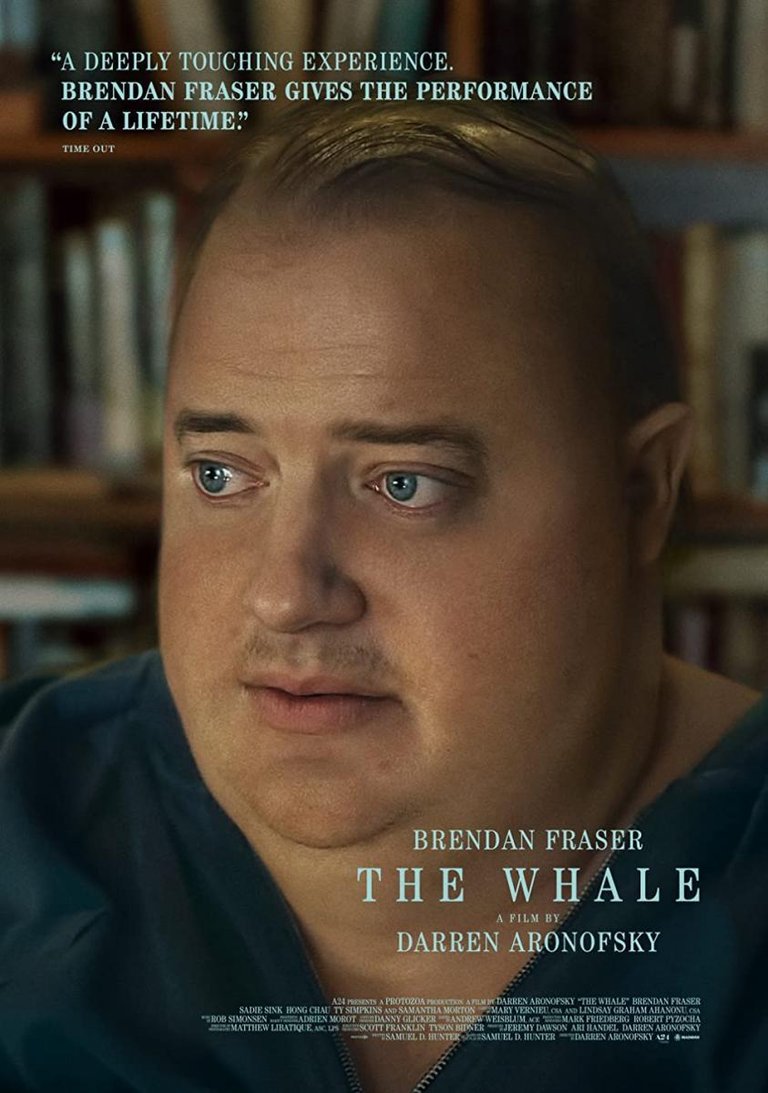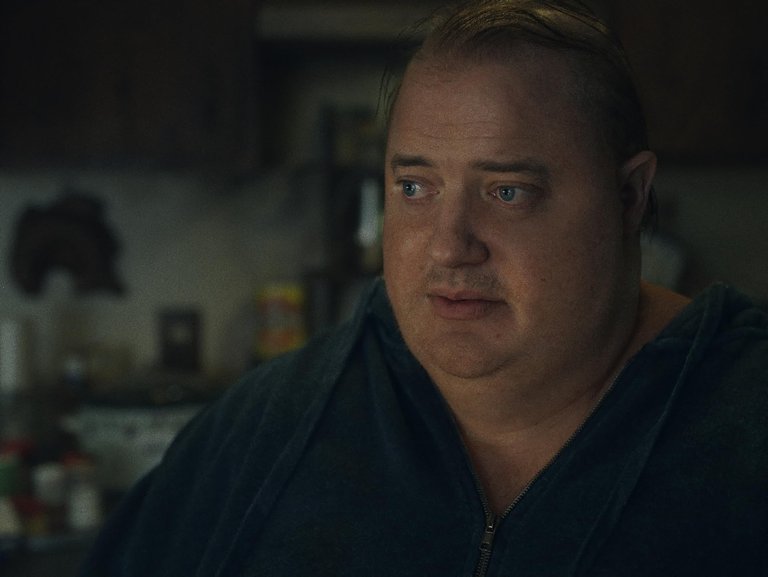Puedes leerlo aquí, o simplemente desplázate hacia abajo en la página.
Hello Hive friends and movie lovers, I hope you are having a nice day. These days, due to situations beyond my control, I have some free time, so I have decided to catch up on my movie list and take some time to write a review on each of them. A few days ago, I had the chance to watch, although I think "enjoy" wouldn't be the right word, The Whale, a deeply moving film that addresses themes of loss, isolation, and redemption through the story of Charlie and his losing battle against morbid obesity.

Confined to his apartment, Charlie struggles to reconnect with his daughter and confront his inner demons, carrying a burden heavier than his own body: the unresolved emotions and conflicts accumulated throughout his life following a series of unfortunate events. The narrative of the film unfolds primarily within the closed space of his home, creating an atmosphere of claustrophobia that mirrors his mental state.

Today, I would like to explore some parts of the movie that, although more hidden, scream to the more attentive viewer. Undoubtedly, weight and obesity, the use of space, and the portrayal of pain and loss are strategically applied symbolisms for a deeper and more disheartening background, filling the work with layers of powerful reflective charge.
Weight and Obesity in The Whale
Before watching the movie, I thought, judging by the cover, that it would be a clichéd story of personal triumph and the visibility of obesity. But in The Whale, the protagonist's weight, Charlie, transcends the physical and becomes a devastating metaphor for his emotional burden. His extreme obesity is a visible manifestation of his deep pain, guilt, and desire for isolation. Charlie's physical state is just the surface of a highly complex character written in the most human way possible. His weight is a self-imposed prison to cope with the loss of his partner and the abandonment of his daughter, situations he, despite trying to make sense of, doesn't know how he arrived at or how to escape. His weight becomes both a shield and a comfort zone for a world he feels deeply disconnected from. It is impossible to observe Charlie and not reflect on how our own emotional burdens manifest in our daily lives and how we sometimes isolate ourselves as a way to protect from pain. It almost feels like a personal attack on the viewer's ego: you could be Charlie, there is nothing separating you from the character, just making wrong decisions, just giving everything up as lost.
The Use of Space
From the first scenes inside Charlie's apartment, we can feel the weight of the space, even smell the rooms, Charlie's heavy breathing, and feel almost impossible to move. The character's reduced mobility is mirrored in us. The claustrophobic environment of Charlie's apartment is a physical extension of his mental and emotional state. The movie uses this masterfully to intensify our sensations of confinement and despair. Every corner of the apartment reflects his isolation, with an almost hermetic feel where objects cluster and windows barely let in sunlight. For a moment, our desires for the character to change, to do something, intensify enormously, but we realize the uncomfortable satisfaction Charlie feels in his emotional retreat, walls that isolate him from a world he gave up on long ago and are now his new universe. As the plot progresses, the apartment becomes a character in itself, perhaps the most sinister of all, symbolizing Charlie's self-imposed prison and his struggle to find a ray of hope in his bleak existence.

Pain and Loss
Half an hour into the movie we realize that obesity in The Whale is the least important aspect of the character; it was the justification to enter his mind and see the depth of his pain and constant sense of loss. And both themes, pain and loss, are addressed in the most diverse and multifaceted ways. Every character we are introduced to has gone through these situations and bears enormous scars. Charlie suffers not only physically due to his obesity but also is overwhelmed by emotional pain, by the loss and hostility of his dearest ones. The film explores how his physical pain is an external manifestation of his inner trauma. The loss of his partner has left him devastated, and his self-imposed isolation reflects his inability to confront and process this pain. The relationship with his daughter is another crucial point, presenting us with purely cruel scenes of constant rejection, blame, and, above all, the loss of the only emotional redemption path left for Charlie. The movie doesn't shy away from showing the rawness of human suffering, awakening in us, the viewers, the most visceral feelings, making us empathize with the complexity of Charlie's emotions and reflect on the ways we deal with our own losses. Through his pain, the characters in the film confront the harshest truths of life, making us question how we face our own fears and losses.

In my opinion, these three elements: the confined space of the apartment, and the various manifestations of pain and loss, manage to create a rich and moving narrative that will not leave us indifferent and will foster certain internal conversations we have tried to silence. Without a doubt, I recommend this movie as an invitation to delve into the complexity of the human experience and the constant struggle to find redemption and understanding. A sharp mirror to our own internal battles, inviting us to reflect on our capacity to face and overcome pain.
I sincerely want to thank you for taking the time to read this article. Your support means a lot to me and motivates me to continue sharing content that can be useful and interesting for you. If you found this article helpful or enjoyed reading it, I would greatly appreciate your feedback. Best wishes.

The Whale - El Peso de las Emociones
Hola amigos de Hive y amantes del cine, espero estén teniendo un lindo día. En estos días, por situaciones ajenas a mi voluntad, estoy teniendo un poco de tiempo libre, así que he decidido ponerme al día con mi lista de películas y tomarme un tiempo para escribir una reseña sobre cada una de ellas. Hace unos días fue el turno de disfrutar, aunque creo que "disfrutar" no sería la palabra correcta, de The Whale, una película profundamente conmovedora que aborda temas de pérdida, aislamiento y redención a través de la historia de Charlie y su lucha perdida contra la obesidad mórbida.

Encerrado en su apartamento, Charlie lucha por reconectar con su hija y enfrentarse a sus demonios internos, llevando consigo una carga más pesada que su propio cuerpo: las emociones y conflictos sin resolver que acumuló a lo largo de su vida tras una sucesión de desafortunados acontecimientos. La narrativa de la película se desarrolla principalmente en el espacio cerrado de su hogar, donde se crea una atmósfera de claustrofobia que refleja su estado mental.

Hoy, quisiera explorar algunas partes de la película que, aunque más ocultas, gritan al espectador más atento. Sin duda, el peso y la obesidad, el uso del espacio y la representación del dolor y la pérdida son simbologías aplicadas estratégicamente para un trasfondo más profundo y desalentador, llenando la obra de capas con una poderosa carga reflexiva.
El Peso y la Obesidad en The Whale
Antes de ver la película, creía que, juzgando por la portada, sería una historia trillada de superación personal y visibilización de la obesidad. Pero en The Whale, el peso del protagonista, Charlie, trasciende lo físico y se convierte en una metáfora devastadora de su carga emocional. Su obesidad extrema es una manifestación visible de su profundo dolor, su culpa y su deseo de aislamiento. El estado físico de Charlie es solo la superficie de un personaje sumamente complejo y escrito de la forma más humana posible. Su peso es una prisión autoimpuesta para lidiar con la pérdida de su pareja y el abandono de su hija, situaciones a las que, por mucho que trate de buscar un sentido, no sabe cómo llegó ni mucho menos cómo salir. Su peso se convierte en un escudo y una zona de confort para un mundo del que se siente profundamente desconectado. Es imposible observar a Charlie y no reflexionar sobre cómo nuestras propias cargas emocionales se manifiestan en nuestras vidas cotidianas y cómo a veces nos aislamos como una forma de protegernos del dolor. Casi se siente como un ataque personal al ego del espectador: tú puedes ser Charlie, no te separa nada del personaje, solo tomar decisiones incorrectas, solo dar todo por perdido.
El Uso del Espacio
Desde las primeras escenas en el interior del apartamento de Charlie, podemos sentir el peso del espacio, incluso hasta oler las habitaciones, la respiración pesada de Charlie y sentirnos casi imposibles de movernos. La movilidad reducida del personaje se refleja en nosotros. El entorno claustrofóbico del apartamento de Charlie es una extensión física de su estado mental y emocional. La película utiliza esto de manera magistral para intensificar nuestras sensaciones de confinamiento y desesperación. Cada rincón del apartamento refleja su aislamiento, con una casi hermeticidad donde se aglutinan objetos y las ventanas apenas dejan colar la luz del sol. Por un momento, nuestros deseos de que el personaje cambie, de que haga algo, logran intensificarse enormemente, pero nos damos cuenta de la satisfacción incómoda que siente Charlie en su retiro emocional, unas paredes que lo aíslan de un mundo que dio por perdido hace tiempo y que ahora son su nuevo universo. A medida que la trama avanza, el apartamento se convierte en un personaje en sí mismo, quizás el más siniestro de todos, simbolizando la cárcel autoimpuesta de Charlie y su lucha por encontrar un rayo de esperanza en su sombría existencia.

Dolor y la Pérdida
Pasada media hora de la película ya nos damos cuenta de que la obesidad en The Whale es lo más secundario del personaje; fue la justificación para entrar en su mente y ver la profundidad de su dolor y el sentimiento de pérdida constante. Y es que ambos temas, dolor y pérdida, se tratan de las más diversas y multifacéticas formas. Cada personaje que se nos presenta ha pasado por estas situaciones y les han dejado enormes cicatrices. Charlie no solo sufre físicamente por su obesidad, sino que también está abrumado por un dolor emocional, por la pérdida y hostilidad de sus seres más queridos. La película explora cómo su dolor físico es una manifestación externa de su trauma interno. La pérdida de su pareja lo ha dejado devastado, y su aislamiento autoimpuesto refleja su incapacidad para confrontar y procesar este dolor. La relación con su hija es otro punto crucial, presentándonos escenas puramente crueles de rechazo constante, de culpas y, sobre todo, la pérdida del único camino de redención emocional que le queda a Charlie. La película no rehúye mostrar la crudeza del sufrimiento humano, despertando en nosotros, los espectadores, los sentimientos más viscerales, logrando empatizar con la complejidad de las emociones de Charlie y reflexionar sobre las formas en que lidiamos con nuestras propias pérdidas. A través de su dolor, los personajes de la película se enfrentan a las verdades más duras de la vida, haciéndonos cuestionar cómo enfrentamos nuestros propios miedos y pérdidas.

En mi opinión, estos tres elementos: el espacio cerrado del apartamento y las diversas manifestaciones del dolor y la pérdida, logran crear una narrativa rica y conmovedora, que no nos dejará indiferentes y fomentará ciertas conversaciones internas que hemos tratado de silenciar. Sin duda, recomiendo esta película como una invitación a profundizar en la complejidad de la experiencia humana y la lucha constante por encontrar redención y comprensión. Un espejo nítido para nuestras propias batallas internas, invitándonos a reflexionar sobre nuestra capacidad para enfrentar y superar el dolor.
Quiero agradecerles sinceramente por tomarse el tiempo de leer este artículo. Su apoyo significa mucho para mí y me motiva a seguir compartiendo contenido que pueda ser útil e interesante para ustedes. Si encontraron este artículo útil o disfrutaron leyéndolo, les agradecería enormemente sus comentarios. Éxitos.

| I’m Ernesto, a Cuban passionate about art and writing. Always learning, always growing. Excited to share and learn more every day! I write about art, drawing, video games, nature, and review the things I like. My goal is to inspire and connect with others through my creative journey. |
|---|
All images, screenshots, and movie posters used in this article are the property of their respective copyright holders. They are used here for illustrative and educational purposes only under the principles of fair use. No copyright infringement is intended. If you are the copyright owner and believe that any content should be removed, please contact us, and we will promptly address your concerns.
Poster obtained from Filmaffinity.
Trailer obtained from the official YouTube page of the movie.
Scenes obtained from IMDb.
Translated with DeepL.com (free version)
I apologize if there are any grammatical errors, English is not my native language, I have tried to be as careful as possible.
I regularly create images on Pixabay, which are free of copyright. Access my gallery by clicking here.
All assets, illustrations and banners have been created by me and are original content, unless otherwise specified.
Aaronofsky es un cineasta impecable, aunque sin duda la mejor parte de todo el film es el performance de Fraser.